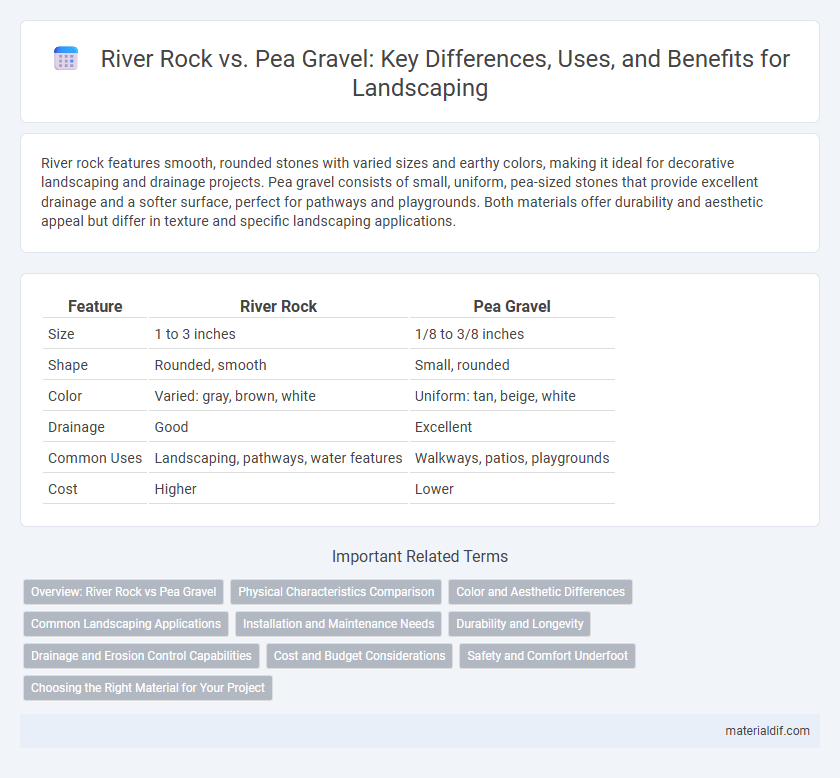River rock features smooth, rounded stones with varied sizes and earthy colors, making it ideal for decorative landscaping and drainage projects. Pea gravel consists of small, uniform, pea-sized stones that provide excellent drainage and a softer surface, perfect for pathways and playgrounds. Both materials offer durability and aesthetic appeal but differ in texture and specific landscaping applications.
Table of Comparison
| Feature | River Rock | Pea Gravel |
|---|---|---|
| Size | 1 to 3 inches | 1/8 to 3/8 inches |
| Shape | Rounded, smooth | Small, rounded |
| Color | Varied: gray, brown, white | Uniform: tan, beige, white |
| Drainage | Good | Excellent |
| Common Uses | Landscaping, pathways, water features | Walkways, patios, playgrounds |
| Cost | Higher | Lower |
Overview: River Rock vs Pea Gravel
River rock features smooth, rounded stones typically ranging from 1 to 4 inches in size, prized for its natural aesthetic and durability in landscaping projects. Pea gravel consists of small, polished, pea-sized stones usually between 1/8 to 3/8 inches, known for excellent drainage and ease of installation. Both materials are commonly used in pathways, patios, and drainage areas, with river rock offering a more rugged appearance and pea gravel providing a softer, uniform look.
Physical Characteristics Comparison
River rock features smooth, rounded edges with larger, irregular shapes ranging from 1 to 4 inches, providing excellent drainage and stability in landscaping applications. Pea gravel consists of small, uniformly sized, rounded stones typically less than 1 inch in diameter, offering a softer texture and better comfort underfoot for pathways and play areas. The denser, heavier river rock resists displacement more effectively than the lighter, looser pea gravel, influencing their suitability for different construction and decorative purposes.
Color and Aesthetic Differences
River rock features a smooth texture with a variety of natural colors, including shades of gray, brown, and tan, offering a polished, organic look for landscaping projects. Pea gravel consists of small, rounded stones that come in a mix of whites, browns, and reds, creating a more uniform and vibrant appearance. The choice between river rock and pea gravel significantly impacts the visual tone of a space, with river rock providing subtle earthiness and pea gravel adding bright, energetic accents.
Common Landscaping Applications
River rock and pea gravel are both popular landscaping materials, but they serve distinct purposes based on their size and texture; river rock, characterized by larger, smooth stones, is ideal for pathways, drainage areas, and decorative accents around water features due to its durability and aesthetic appeal. Pea gravel, consisting of small, rounded stones about 1/4 inch in diameter, is commonly used for playgrounds, patios, and garden beds because it provides excellent drainage and a softer surface underfoot. Garden designers often select river rock for erosion control, while pea gravel is favored for cushioning and ease of installation in high-traffic areas.
Installation and Maintenance Needs
River rock requires careful installation with a sturdy base to prevent shifting and is ideal for areas with moderate foot traffic. Pea gravel is easier to install, typically laid directly on a weed barrier, and demands minimal maintenance thanks to its rounded shape that resists compaction. Both materials benefit from occasional raking and replenishing, but pea gravel generally offers lower upkeep costs and faster installation times.
Durability and Longevity
River rock offers superior durability and longevity compared to pea gravel due to its larger size and denser composition, making it less prone to shifting and breaking down over time. Pea gravel, being smaller and smoother, tends to wear down faster and may require more frequent replenishing in high-traffic or erosion-prone areas. Choosing river rock ensures a longer-lasting landscape material that maintains structural integrity even under harsh environmental conditions.
Drainage and Erosion Control Capabilities
River rock features larger, smooth, and rounded stones that create ample gaps for superior drainage, reducing water pooling and promoting efficient runoff management. Its heavy, stable composition excels in erosion control by resisting displacement during heavy rains and water flow. Pea gravel, with smaller and more uniform stones, offers moderate drainage but is more prone to shifting, making it less effective than river rock in preventing soil erosion.
Cost and Budget Considerations
River rock typically costs between $200 and $300 per ton, making it a more expensive option compared to pea gravel, which ranges from $20 to $50 per ton due to its smaller size and easier availability. Pea gravel is often preferred for budget-conscious landscaping projects because it provides adequate coverage at a lower price point while maintaining aesthetic appeal. When planning a project, factoring in delivery fees and installation costs can further influence the overall budget for either river rock or pea gravel.
Safety and Comfort Underfoot
River rock features smooth, rounded stones that provide a stable and comfortable surface, reducing the risk of sharp edges causing foot injuries. Pea gravel consists of smaller, pea-sized stones that shift more easily, which can lead to uneven footing and potential slips or falls. For pathways and play areas where safety and comfort underfoot are priorities, river rock is generally the better choice due to its larger, more stable texture.
Choosing the Right Material for Your Project
River rock offers smooth, rounded edges and a natural appearance, making it ideal for landscaping features where aesthetics and drainage are priorities. Pea gravel consists of smaller, uniformly sized stones that provide excellent compaction and stability, perfect for walkways, driveways, and playgrounds. Selecting between river rock and pea gravel depends on your project's need for decorative appeal versus functional support and ease of maintenance.
River Rock vs Pea Gravel Infographic

 materialdif.com
materialdif.com